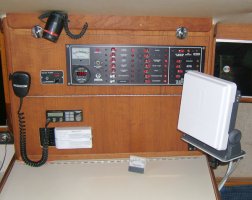Incomplete AH Meter install...
Sigh...
Sometimes I feel like one of the less-educated followers of Ned Ludd. But, first the good news : our house battery bank appears to be in good condition. (Two Trojan T-145's, about 4 years old.)
Having run the boat on that bank (no shore power charger) since Sunday afternoon until noon today, Thursday, to power the refrigeration and some incidental use of lights, fans and the water pump while purging the 38 gallon tank, I started the cold diesel M25XP with no drama at all, off that same battery bank.

The new meter was showing about 12.25 volts today, and we started out this little draw-down exercise at about 12.8. A friend did observe that it went down to about 11.8 when I used the glow plugs for 10 seconds and further dropped to 10.8 for a split second when the starter turned over. The starter turned briskly, FWIW.
The cockpit instrument panel immediately show almost an even 60 amp charge on the analog meter, which is max for the stock Moto alternator.
Now the other news: no amps were showing on the AH meter going back in.

Since my friend has the same meter on his similar engine in his Ericson, he asked me some simple questions about my install.

(He did not call me an idiot, but there was a sort of "look" in his eyes...)
Like, was any other cable going to the neg. side of that battery? Hmmm. I could see, after a bit of dialog, where Big dummy Me had done an incomplete installation!
I write of my short-sighted-ness only because a lot of you have the same engine and basic wiring layout in your 80's-era Ericsons and Olsons, and you should avoid the tunnel-vision problem that led me astray.
The factory 1-2-All switch has both red #1 cables from the "house" and "start" batteries. They never called them that when the boat was built, though. The equally-large neg. (black) cables from both batteries go to a 5/16 bolt on the port side of the bell housing, beside the motor mount bolt. That common ground point also has the #4 black cable coming from the "house" DC distribution panel.
Where I went wrong was in focusing only on the House distribution panel power usage and not realizing that the so-called house battery bank was not isolated to only the new shunt I was installing.
Mea Culpa. What I did was add a short piece of #4 black from the common ground bolt to the shunt, which was mounted nearby in the engine compartment, and from the shunt the existing #4 black cable goes over to the house distribution panel. It works great for measuring volts and amps for that panel, but cannot (as is obvious now even to me) read what goes into the battery in the form of charging.
:nerd:
Vacation starts very soon and adding the shunt poses no harm that I can see, but I do need to change the DC neg. to show everything going/entering that "house" battery bank. The AH calculation cannot work the way it is now -- the AH reduction just keeps going.
And that leads to a question: If/when I do that, will the stock #4 cable to and from the panel carry the glow plug and starter amperage OK when this "house" bank is used for emergency starting??
(With the stock factory system, the cable runs for the starter motor are short and are all big fat #1 cable.)
This should have occured to me during the wiring install, but I was focused on the house panel and did not see the now-obvious charging by-pass I allowed.
"Two steps forward, one back."
Too much technology for me...
It must be time to go out and take a whack at a knitting machine!

Loren



